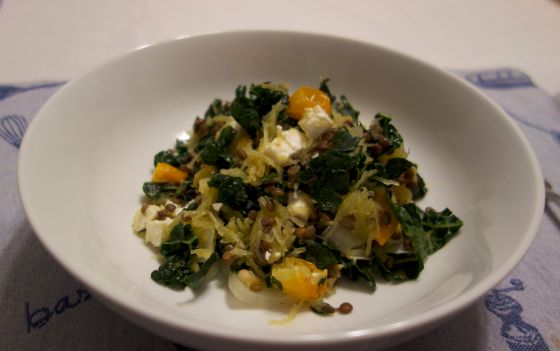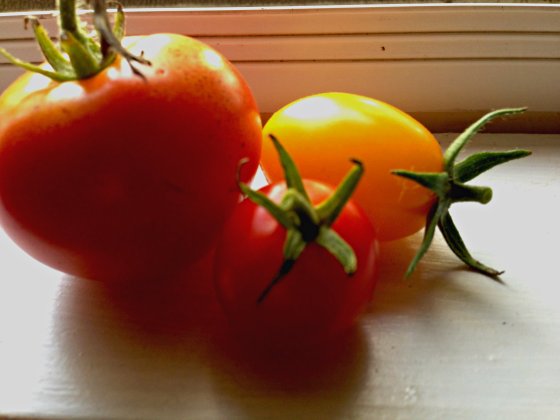You know all those Pinterest post that try to convince you that spaghetti squash is the perfect substitute for pasta? I’m going to tell you something: They are lying. Spaghetti squash is stringy like spaghetti, and it can work really well with some sauces, but the texture and moisture levels are completely different.
Instead of pretending spaghetti squash is something it’s not, let’s embrace it for what it is: A really easy to prepare food that can add an exciting taste, color and texture to your recipe. And, it’s pretty dang healthy.
For this recipe, I tried to balance out the lighter squash flavor and texture (spaghetti squash doesn’t have nearly the same flavor presence as pumpkin or butternut squash) with taste and textures that were both earthier and sweeter. I’m really happy with the results, which make a very satisfying main dish for vegetarians.
Spaghetti Squash with Lentils de Puy, Kale and Feta
Ingredients
- 1 large spaghetti squash
- 3 tablespoons olive oil
- 1 teaspoon seasoning salt or seasoning blend with salt and paprika
- 2 cups water
- 1/2 cup green lentils de Puy
- 1 small bunch laminate kale or other hearty green, sliced into ribbons.
- 1 pint grape or cherry tomatoes (I used yellow), cut in half
- 1 small onion, sliced
- 1/3 cup crumbled or diced feta
- Handful toasted pine nuts (for garnish, optional)
Directions
- Preheat the oven to 350° F. Cut the squash in half lengthwise and scoop out the seeds. Mix 2 tablespoons of the olive oil and seasoning salt in a small dish. Generously brush the mixture over the inside edges and scooped out center of the squash (you do not need to coat the rind). Pour any extra into the centers of the hollowed out halves. Wrap each half in tin foil and bake in the oven, cut side up, for 40 minutes.*
- Combine lentils and water in a covered pot over high heat. Bring to a boil, then turn the temperature to low and simmer for 30 – 40 minutes, until the lentils are soft. (Unlike other lentils, green lentils de Puy will retain their firm shape, so remove some with a spoon to test.)
- While the lentils are cooking, give the kale a bit of a massage (you do not need to do this with other greens), rubbing the ribbons together with your fingers until they are soft. I can’t eat raw kale, so I added it to the lentil pot to steam just as the lentils were finishing, and let it sit in the hot pot with the lid on until I was ready to add it to the squash. If you prefer raw/massaged kale, you can skip that step.
- In a large pan, heat the remaining oil. Add the onions and sauté until soft, then add the tomatoes and continue to cook over medium heat.
- Remove the squash from the oven and carefully open the packets, taking care not to drip out the oil. Using a fork, flake and scrape the inside of the squash, which should easily form long strands. Add to the mixture in the pan, and pour in any leftover oil.
- Add the lentils and kale to the pan, straining out any excess water. Use a large serving fork or tongs to gently mix the ingredients. Top with the crumbled feta and pine nuts. Serve immediately.
* If it’s warm enough to grill, there’s an a wonderful alternative way to prepare the squash using the same three ingredients. Mix the oil and seasoning salt as above, but instead of slicing the squash in half length-wise, cut it half so the stem is on one half and the bottom the other. Scoop out the seeds, then slice the squash into large rings, about an inch thick. Brush all the exposed parts of the flesh with the oil mixture, and cook it on a hot grill. On the grill, it gets some nice caramelized pieces. You can use a fork to pull the strings from the rind, just as with the above method.**
** As another alternative, you can make tinfoil packets and throw those on the grill. Grilled spaghetti squash is one of my dad’s specialties!
































